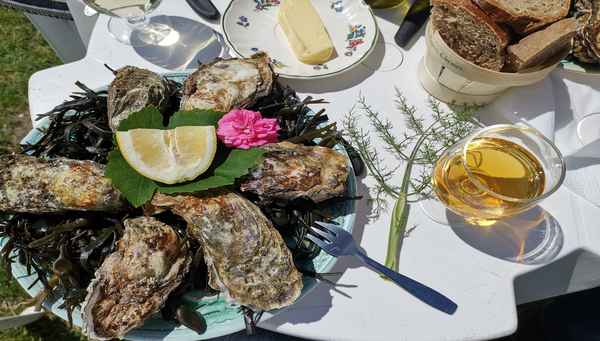Culinary delights of Brittany
Gourmets love the culinary delights of Brittany, be they from land or sea. Let me tempt you with my gastronomic tour of Breton cuisine. Recipes included!
Brittany’s contribution to French cuisine is undeniable. Who has not heard of crepes, cider, salted butter caramels or galettes (buckwheat pancakes) to mention just a few? Located in France’s north western region, its long coastline also makes it a haven for seafood lovers!
I love what the official website of tourism in Brittany (a gem of a website!) wrote about Breton cuisine (see photograph below). It encompasses all that I love about Breton produce and its cuisine.
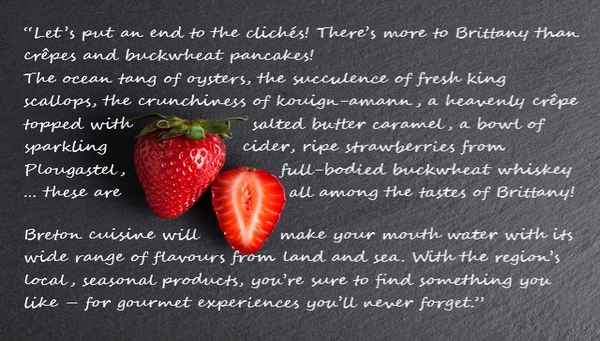
Above text : courtesy of Brittany Tourism website (with many thanks!)
Top Food & Drinks in Brittany, France from Crêpes to Cider
List of contents
Seafood in Brittany
Brittany’s long coastline from north to south makes it a paradise for seafood lovers. We are truly spoilt for choice in Brittany.
Fish:
Here is an illustrated list of the various types of fish that one can find in Brittany during the four seasons.
In winter (hiver), there are 21 types of fish available.
In spring (printemps) – 18 types of fish available.
In summer (été) – 19 types of fish available.
In autumn (automne) – 21 types of fish available.
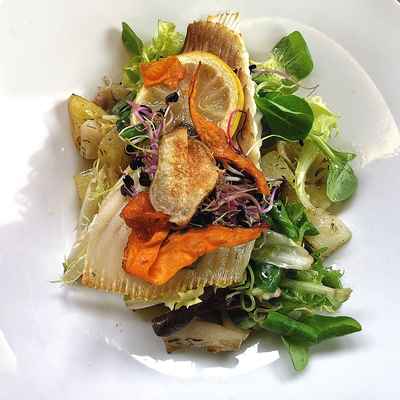
Skate (aile de raie), potatoes, capers in butter sauce & salad
Cotriade:
This is a traditional French fish stew from Southern Brittany. It is made with different types of fish such as mackerel, hake, red mullet, conger eel, sprats and herring, along with onions, garlic, potatoes, leek, oil, vinegar and herbs (bouquet garni). See photo and recipe here.
When served, the broth is eaten first, followed by the fish and vegetables. It is sometimes poured over toasted bread. The more fish there is in the stew, the better the cotriade. In the past, it was a regular staple dish for local fishermen and their families.
Oysters:
Think of the sea and Brittany and oysters naturally come to mind. Oysters can be found in 12 regions of Brittany, the most famous being Cancale (Northern Brittany) and Riec-sur-Bélon (Southern Brittany). Since 2019, oysters from Cancale are mentioned in UNESCO’s List of Intangible Cultural Heritage.
One of the many joys of living in Brittany is the possibility of eating oysters almost all year round. However, they are best eaten during the months that end in « r ». In summer, they could be rather milky or cloudy in appearance but some like them that way too.
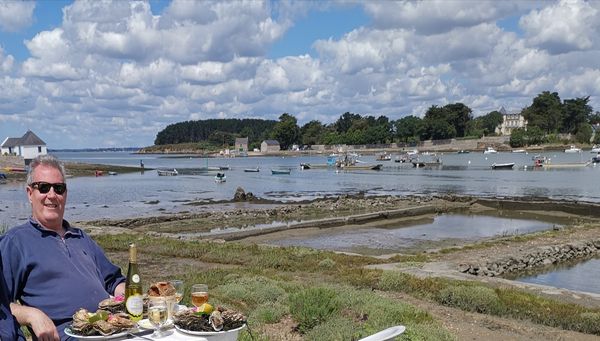
What’s not to love – dining near oyster beds, the beautiful Gulf of Morbihan in Southern Brittany!
Mussels:
Mussels mainly come from Northern Brittany (Bay of Mount St Michel and Bay of St-Brieuc), although they are also found around Pénestin in Southern Brittany. They are eaten from July to January.
Breton Moules Marinières are renowned as this seafood dish is made with cultivated mussels that grow directly on the seabed, on ropes or on stakes (« bouchots »). Typical of Brittany, these mussels are quite small, but tasty and fleshy.

Moules marinières (with cream) and chips

My daughter enjoying her cider with mussels!
To fully enjoy their flavour, shellfishes are cooked in French white wine with parsley and shallots. Modern versions of moules marinières include cream, garlic, peppers, chorizo etc. and come with « frites » (chips) of course!
Learn how to cook Moules Marinières. However, if you only want the recipe, I would suggest clicking on this link here.
Crepes and Galettes
Most foreigners are aware that crepes are from France, but many do not realise that they originated in Brittany.
Whilst crepes are made with wheat flour and used for desserts, galettes are made from buckwheat (« sarrasin » or « blé noir ») and are mostly savoury. Galettes originate from the Gallo region of upper Brittany, whereas crepes, made from wheat or buckwheat flour, are from lower Brittany. I have noticed that galettes from the Finistère department of Brittany are much darker to the ones found in the Morbihan due to a different quality of buckwheat flour used.
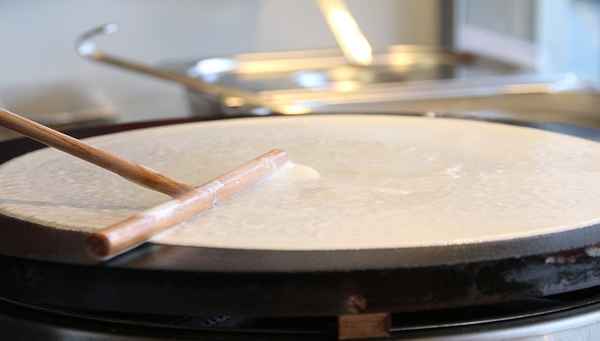
Making a perfect crepe or galette requires mastery and a set of tools such as:
The above video is just to show you how the professionals make them. The video below will show you how most of us make them at home!
Fun fact:
On 2 February, 40 days after Christmas, all of France celebrate Candlemas or “chandeleur” or the festival of “chandelles” (candles/lights). To mark this Christian festival, the French eat crepes as they symbolise the sun and the return of spring.

galette complete (ham, cheese & egg)
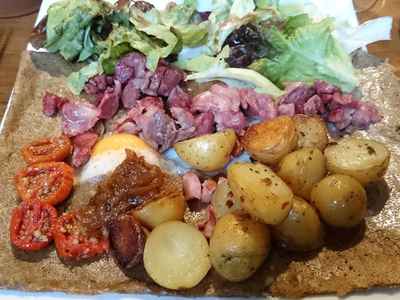
savoury galette
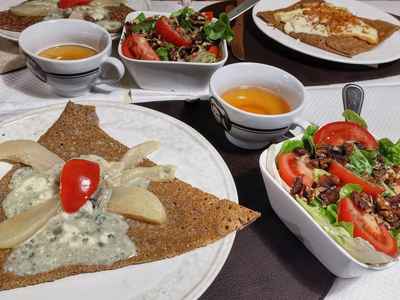
Galette with roquefort cheese, pears and walnuts
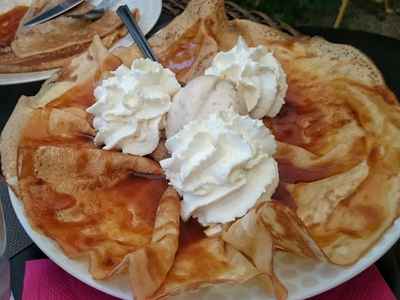
Crêpe with salted caramel butter sauce and ice cream
Breton meat dishes
Brittany being a pig rearing region of France, it goes without saying that pork is often on the menu in homes and restaurants. Apart from having pork in main dishes, they are widely used in « charcuterie » such as patés, terrines, « rillettes » (potted pork) to name a few.
Galette saucisse :
This classic street food item hails from Rennes in Ille-et-Vilaine departement. Usually sold at food trucks and during Breton fêtes, galette saucisse consists of a buckwheat crêpe wrapped around a grilled pork sausage with a choice of condiments such as mustard, mayonnaise, etc. It is believed that this dish goes back to the 15th century when the original snack was prepared with pork offal.
Andouille de Guéméné:
You either love or hate this! The Andouille de Guémené is a typical Breton sausage made from pork chitterlings, pepper, onions and seasonings which is served hot or cold.
The Breton « andouille » is a meat dish that dates back to the 18th century. However, the celebrated « andouille de Guéméné » only appeared in the 20th century. The latter is made from tripe rolled up from the pig’s large intestine. Some 20 to 25 guts are required to make an andouille de Guéméné, hence its recognisable concentric circles when sliced.
Boudin noir:
A boudins noir is a black pudding which is usually eaten with stewed apples and mashed potatoes. It is not only a Breton speciality, but also Norman. The spicy version of this boudin comes from the French Antilles.
Kigh Ha Farz:
Kigh ha farz is a traditional peasant’s dish and comes from Finistère. The cheapest cuts of pork and/or beef are slowly simmered with vegetables (like carrots, onions, celery, leeks, turnips etc.) in a broth together with a buckwheat flour dumpling. In the olden days, this dish would be prepared in the morning, left to cook all day, and eaten at night.
Fishermen would normally make this dish using the unsold fish from their catch, known as the « pesk ha farz ». It is the Breton version of the French « pot au feu ». Check out Finistère Brittany’s website for the recipe in English.
Fun fact:
Brittany was one of the first French regions to gain access to curry powder and exotic spices, thanks to the spice trade carried out by the French East India Company based in Lorient (name derived from The Orient). To this day there is a unique curry blend called « Kari Gosse” only sold in pharmacies in Auray. Apparently, it is a secret blend of aromatic spices with an accent on fiery and hot!
Breton cheeses
Cheeses in Brittany are abundant due to the numerous green pastures dotted with cows and goats. There are many artisanal cheeses made on small farms which shall be the topic here. I shall therefore skip the industrially made cheeses.
Mark Greenfield, ex Head Chef of Le Végétarium restaurant , currently hosts culinary workshops at the newly opened La Bergerie , both part of the of Yves Rocher Group in La Gacilly. He has kindly shared with us his selection of local, organic cheeses that he highly recommends.
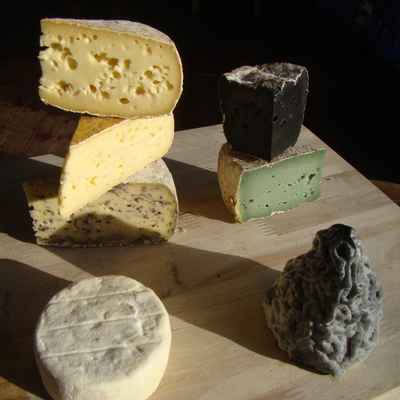
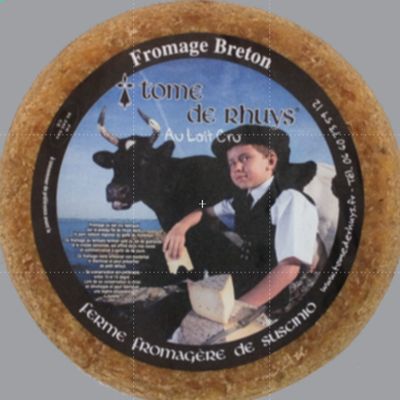
Interesting links for organic local cheeses and their addresses:
A portrait of an atypical Chef in Brittany:

Breton desserts and bakes
If you have a sweet tooth, you will love what I am going to reveal to you. I know, I was tempted myself to skip the main course and even the cheeses to get to the desserts, but that wouldn’t have been fair on the others!
Kouign Amann:
Kouign-Amann is a classic Breton speciality that was accidentally created around 1860 in the coastal town of Douarnenez. It all started when a busy baker ran out of pastries to sell and decided to quickly combine bread dough, butter and sugar.
Made of 30% sugar and 30% butter, the Kouign Amann has got to be the fattiest pastry in all of Europe. The authentic Breton recipe consists of multiple layers of alternating brioche dough, butter, and sugar. Its name is derived from the Breton words for cake (kouign) and butter (amann).
A pleasure to watch how the dough is combined, but if you just want the recipe without the video, here it is.
Due to its success, there are many industrial variations. The bakers in Douarnenez therefore decided to form an association in 1999 in order to protect their invention and expertise. As a result, their produce is labelled as being the « authentic kouign amanns from Dournenez – traditional artisan produce invented in 1860 in Dournenez. »
Far Breton:
The authentic Far Breton (« Farz Fourn ») is a savoury flan with onions and lardons served with traditional meat dishes in the 18th century. From the 19th century onwards, the sweet version gained wide appreciation.
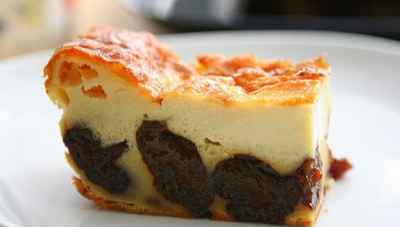
This Breton speciality rapidly became a traditional dessert for family meals and religious celebrations. The recipe has evolved with the times. It is now common to add vanilla sugar, warm tea, rum or plum liqueur in the far dough mixture. Here is a bilingual recipe for you to try.
Did you know that there are 60 types of far breton? The far breton or the farz fourn in Breton, the farz pitilig, the far buan etc.
Breton biscuits – galettes and palets:
They are rich and crunchy butter biscuits. Galettes are thinner, whereas palets are thicker. They are also known as Traou-Mad which means “good things” in Breton.
Want to try making palets? Here’s a good recipe courtesy of Brittany Tourism.

Palet biscuit, Breton whisky crème brûlée
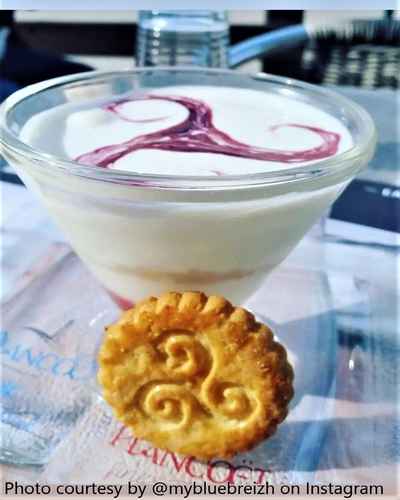
Thank you @mybluebreizh
Gateau Breton and Quatre Quarts:
Gateau Breton is a shortcake because of its high butter content. Why not try this recipe!
Quatre Quarts is a Breton pound cake and is a big favourite in my family. It is known as such (four quarters) as its four ingredients, namely flour, butter, sugar and eggs, are of the same weight. Tip: you weigh the eggs to measure the other ingredients. Here’s a mouth-watering picture and recipe.
Salted butter caramel:
Butter in Brittany has to be salted, even for cakes. I, personally, love salted butter because it enhances the sweetness. Brittany is also a salt producer. The famous salt marshes of the Guérande region is worth visiting for its scenic views of the salt pans.
It, therefore, comes as no surprise that we have salted butter caramel (in sweet and sauce forms) in Brittany. I read years ago how President Obama loved this delicacy. Who does not love « Caramel au beurre salé »!

Soft caramel sweets were created by a Quiberon-based Breton chocolate maker, Henri Le Roux, in 1977.
However, a delicious salted butter caramel sauce, known as « le Salidou » was created by Alain Audebert back in 1966. Natural and simple ingredients, like milk, butter, fresh cream, fine sea salt from Guérande, are cooked to make this delicious sauce that are used for crêpes, desserts and other dishes.
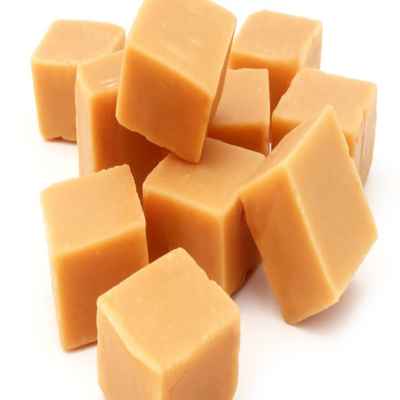
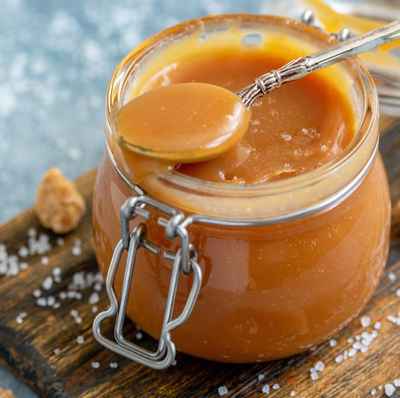
Drinks in Brittany
When I first moved to Brittany some 20 years ago, my impression was that Brittany made cider, spirits from cider and beers. How wrong I was! In time I learned that Brittany produces a wide selection of drinks from non-alcoholic to spirits.
Non-alcoholic Drinks:
It is not for want of patriotism that many Bretons (my children included!) prefer the Breton cola, known as the Cola from the « Far West » (Phare Ouest, also the name of the company). A clever pun!
Delicious apple and pear juices are also produced and sold locally.
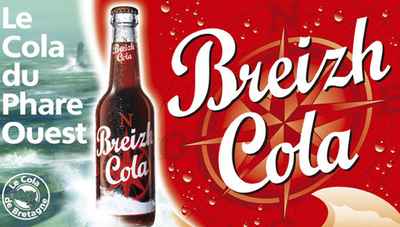
The all-important Cider:
Breton cider is the main drink that accompanies most Breton meals, such as a « bolée » or bowl of cider with a crêpe or galette. In 2000, Breton cider earned its protected geographical status (IGP: Indication Géographique Protégée) which means that only cider produced in Brittany (including parts of Loire Atlantique, Maine et Loire and Mayenne departements) can be sold as « Breton cider ». Click here to see a delightful map of Brittany where cider is produced.
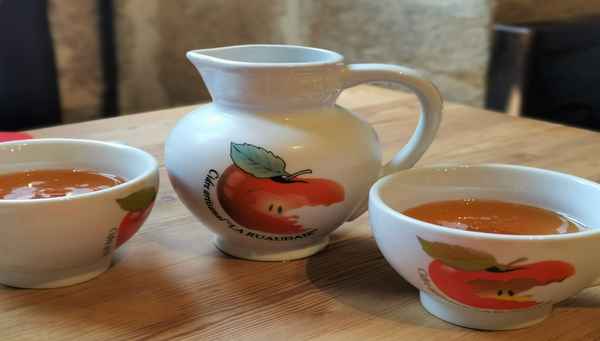
A jug of cider and 2 « bolées » (they look like tea cups without saucers).
Breton cider contains 2% to 7% of alcohol content and is classified as « doux » (mild), « demi-sec » (medium dry) to « brut » (dry). Cider is also the base for making « pommeau de Bretagne » and « lambig Breton » which I shall mention further on.
Craft beers from local and micro-breweries:
There are numerous breweries (including micro-breweries) all over Brittany. For this article, I shall mention « La Brasserie Lancelot » in Le Roc-St-André (56) because I lived in that part of Brittany (Lizio and Sérent) for 12 years. Besides, I am a big fan of Arthurian legends.
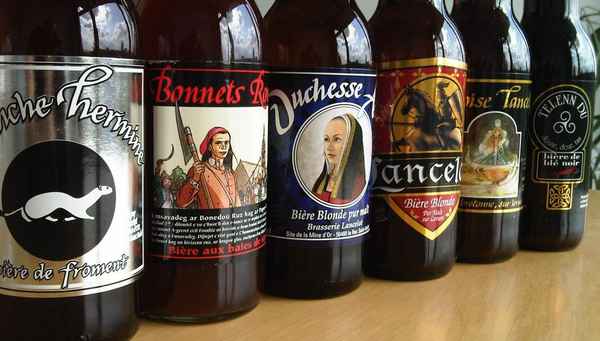
The Lancelot brewery has many types of beers which are named after Arthurian and Breton legends such as Lancelot, Blanche Hermine (White Ermine), Bonnets Rouges, Morgane, Duchesse Anne etc.
The brewery was founded in 1989 by Bernard Lancelot, and was taken over by Stéphane Kerdodé and Eric Ollive in 2005. On 1st January 2021, it was sold to the cooperative Agrial that owns brands such as Breizh Cola, Kerizac and Loic Raison cider, Danao (yoghurt based fruit drinks) etc.

Breton wines:
Brittany, a wine-growing region? Well, it was so in the past with some 800 hectares of vineyards in 1848. However, it was particularly under Louis XIV and XV that Breton farmers were asked to grow cereals instead to feed Paris (who were getting their wines from the south). It is good to know that wine making has not dried out.
Until 1st January 2016, the creation of new vineyards was banned until the European Union relaxed the rules (+1% per year). As of May 2021, 18 vineyards have been registered in Brittany. The dominant varieties are Pinot Noir, Chardonnay, Pinot Blanc and Chenin.
The largest white wine growing region in Europe is in the Loire-Atlantique around Nantes, which was historically a part of Brittany. The desire to annex Loire-Atlantique back to Brittany is growing! The Muscadet is perhaps one of the most well-known wines from that region and go very well with seafood.
For maps of past and present wine growing areas in Brittany, do look at these maps here.
For more information in English, click on this link.
Pommeau de Bretagne AOC, Chouchen and Lambig:
Pommeau de Bretagne is an aperitif (17% alcohol) made from unfermented apple juice and cider brandy.
Chouchen (apple mead) is made from unfermented honey and is drunk as an aperitif or a digestif. It is also used in Breton cuisine.
Lambig or Fine de Bretagne is apple brandy. Apple cider is distilled to produce a 70% alcohol-content brandy which is watered down to the authorised 40% content. If stored in oak barrels, the cider brandy can become a « Fine de Bretagne » with an AOP classification.
Fun fact:
A member of every Breton family used to have the licence (until his death) to make apple brandy, colloquially known as the « goutte » (the drop) due to the distillation process. If you receive such a bottle, consider yourself very lucky indeed as these licences are extremely rare these days.
Breton whisky:
in 2015, Breton whisky was awarded its protected geographical status. To be considered as a Breton whisky, it must be brewed (with water from Brittany), fermented, distilled and aged in Brittany. It should have a minimum of 40% alcohol content and aged for at least 3 years in oak barrels. Malted barley, buckwheat, spelt wheat, corn, rye or wheat could be used to make Breton whisky.
Conclusion:
I hope you enjoyed my gastronomic tour of Brittany. There is so much to say and I have tried to keep the guide brief and informative (even though this must be my longest newsletter)! I have added many links with additional information should you wish to learn more.
Other Sources:
